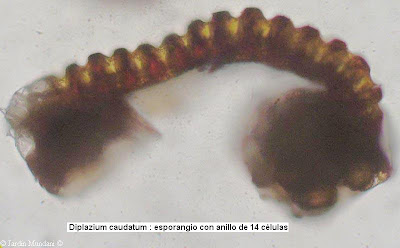This beautiful fern is an Iberian-Macaronesian endemic species living in all the islands of Macaronesia: Canary Islands, Azores, Madeira and Cape Verde and in the region of Algeciras in the Cadiz province, including in the Natural Park of Los Alcornocales, which persists a habitat similar to the laurel forest, warm and humid throughout the year. Belongs to the family of Athyriaceae and its genome contains 82 chromosomes (2n = 82, n = 41). It is a relic of the Miocene, like other Iberan-Macaronesian or African-Iberian-Macaronesian ferns, such as Woodwardia radicans, Culcita macrocarpa, Asplenium hemionitis, Davallia canariensis, etc.. During the Tertiary these ferns filled the greater part of the Mediterranean.
Fine example of Diplazium caudatum growing in the Caldeira do Faial in the Azores Archipelago. Double clicking on the picture to enlarge you can see the bright eye-catching black rachis of the fronds, characteristic of this fern.
Diplazium caudatum group growing in shaded, moist slope of a rush of Faial Island. We can see the rhizomes and leaves some alien invasive Hedychium gardneranum, competing for the same habitat and endangers the survival of this beautiful little paleomediterranian fern
Young specimen of Diplazium caudatum grown in the Jardin botanico del Aljibe, located in the town of Alcalá de los Gazules where retain endemic ferns more representative of the laurel forest of Cadiz.
Laurel understory, shady, moist habitat ideal for Macaronesian fern. Photograph taken in the beautiful Bosque de Los Tiles on the Canary island of La Palma. Enlarging the picture with a double click we can see a large population of Diplazium caudatum. These relict forests are impressive silence, broken only by the tinkling of drops of the horizontal rain falling from tops of the trees and the guttural singing the beautiful endemic laurel rabiche and turque pigeons. The air smells good soil, healthy and fresh. It is a pleasure to breathe deeply to oxygenate the blood.
Old copies of Diplazium caudatum of Bosque de Los Tiles. We can see the creeping shoots of endemic Hedera canariensis.
In the Canary Archipelago live in Tenerife, Gran Canaria, La Gomera and La Palma in ravines and forests of laurel permanently damp, shady, deep, between 250 and 800 meters. It needs warm temperatures throughout the year without sudden changes or frost. It is classified as vulnerable on the IUCN Red List of Spanish Vascular Flora of 2008.
Beautiful new Diplazium caudatum frond can reach 190 cm, which makes this fern in the third largest in the Macaronesia, behind Woodwardia radicans and Culcita macrocarpa. We can see how the black spine is changing to green as it approaches the apex of the blade. On its underside the black color reaches almost to the apex. The blade is ovate or ovate-lanceolate, tripinnate and glabrous on both sides, dark green when fully developed.
In this picture we can see the long thin caudate or acuminate apex of the pinnae, detail for which was given the name "caudatum". (Double click on the photo to enlarge)
Details of the pinnules of Diplazium caudatum. It is very striking and bright deep black color of the spine, which changes to green as it approaches the apex of the blade and pinnae.
Detail of the spine stained black and shiny. (Double click on the photo to enlarge)
Long shiny and black petioles, blackish brown or brown-green of Diplazium caudatum, which can exceed the 80 cms. and are shorter than the blade. At the bottom are covered with dark-brown and opaque paleae. The rhizome is creeping and may reach up to 40 cms. long and 10 cms. in diameter in older individuals. Sprout fronds at intervals of 1 cm. each other.
Immature oblong sori of Diplazium caudatum with the indusium not yet lifted, arranged in two parallel rows along the midrib of each pinnules.
Mature sori with raised indusium and deployed sporangia, dispersing the spores.
Sporangium of Diplazium caudatum with the bag ripped, but still without dispersing spores.
Diplazium caudatum spores under the microscope at 400 magnification.
Diplazium caudatum spores germinate easily. In the picture we can see a small staff of young specimens newly transplanted to individual flowerpots, from spores of the fern of the first picture of this article. The strongest who survived the transplant, donated to the Botanical Garden of Soller to enrich its magnificent collection of Macaronesian plants.















No comments:
Post a Comment